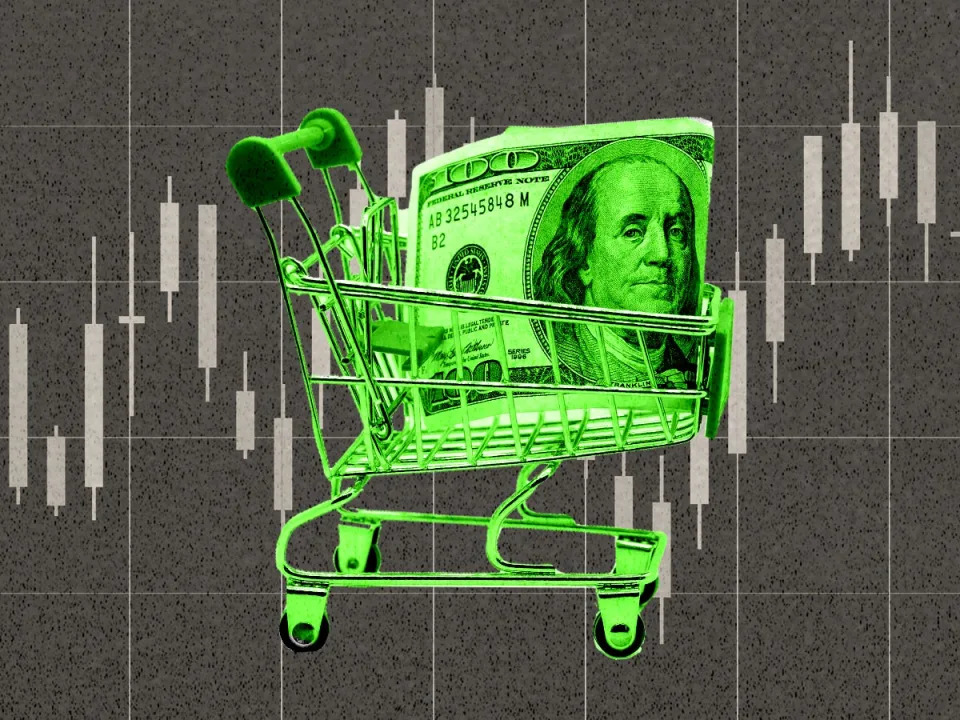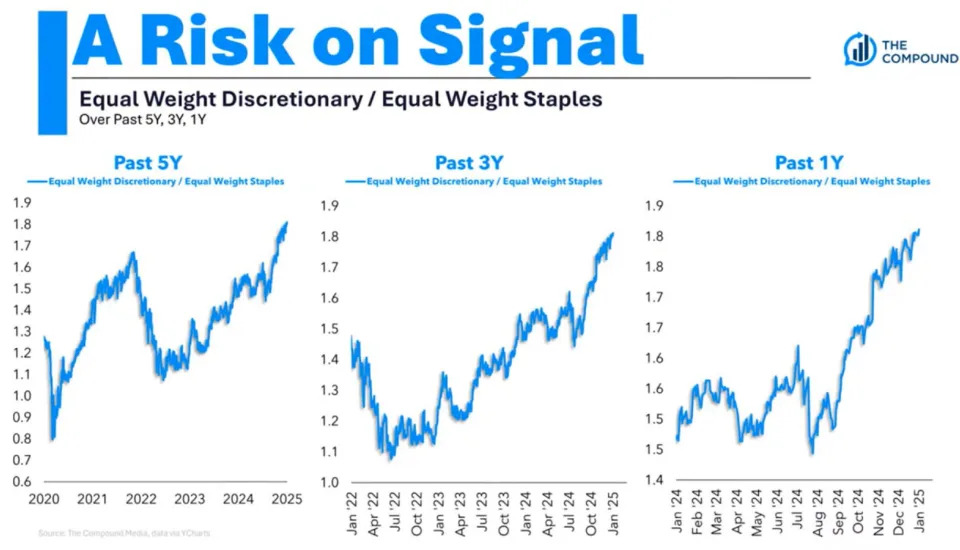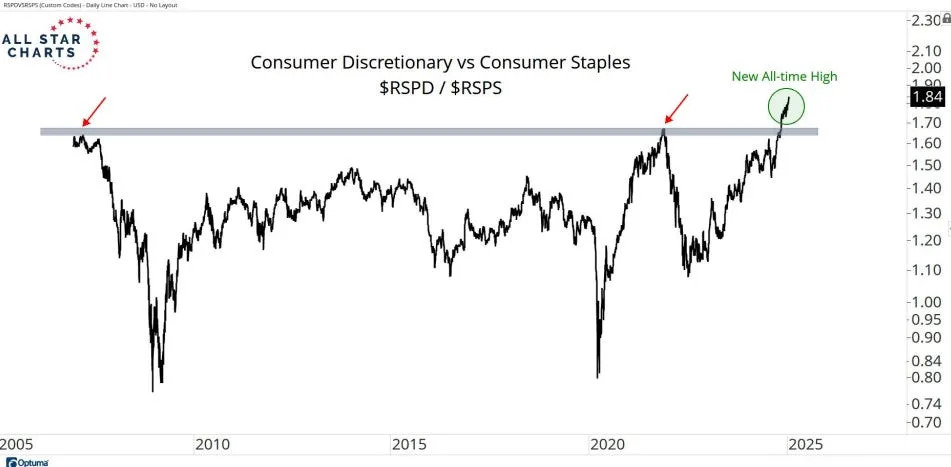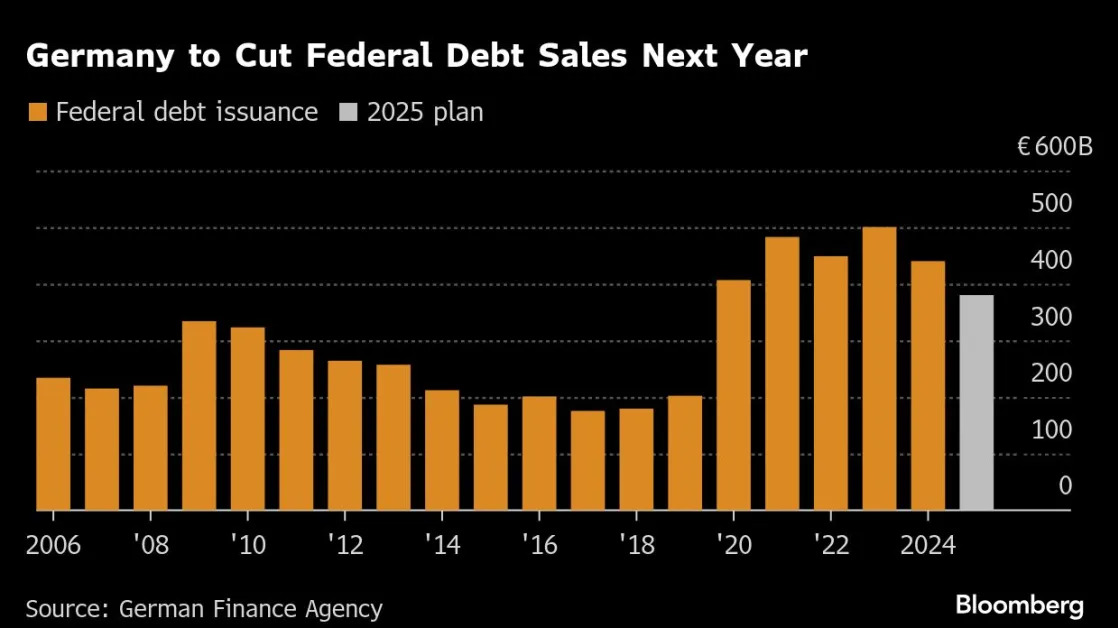
The stock market is flashing an under-the-radar bullish signal that suggests the ongoing rally is set to stretch into 2025.
The signal is simple, but powerful: the outperformance of risk-on stocks relative to defensive stocks has hit record highs.
Specifically, consumer discretionary stocks have reached new highs when measured against consumer staples stocks.
Consumer discretionary stocks are considered risky because they reflect non-essential spending, whereas consumer staples stocks meet consumers' necessities.
The thinking goes that consumers will continue to buy products from companies within the consumer staples sector even when the economy is slowing or contracting. At the same time, they reign in their spending on discretionary items in times of economic distress.
"Defensive stocks tend to lead when there's trouble and we just aren't seeing that," Ryan Detrick, chief market strategist at Carson Group, told Business Insider. "That's a good thing."
Some of the top companies in the consumer discretionary sector include Amazon , Tesla , Home Depot , and McDonald's . The top companies in the consumer staples sector are Costco , Walmart , and Procter & Gamble , which sells toilet paper, soap, and diapers.
The widening performance gap signals that investors are comfortable betting on the consumer continuing to spend their income on goods they don't necessarily need but want, given that the economy remains on solid footing.
The performance gap between the two sectors is striking.
Year-to-date, the consumer discretionary sector is up nearly 3% compared to a 2% decline in the consumer staples sector.
And over the past year, consumer staples are up just 7% compared to a 34% gain for consumer discretionary. The outperformance persists looking back three and five years as well. Meanwhile, the S&P 500 is up 2% year-to-date and 27% over the past year.
From a fundamental perspective, Arun Sundaram, senior equity analyst at CFRA Research, told Business Insider that a strong labor market has boosted consumer discretionary stocks. At the same time, concerns about GLP-1 weight loss drugs have exacerbated the decline in consumer staples stocks.
"Investors are questioning the long-term impact of revolutionary weight loss drugs like Ozempic on food and beverage companies, which dominate the Consumer Staples sector," Sundaram said.
But putting aside what's fundamentally driving the widening divergence in performance between the two sectors, this is typical investor behavior in a bull market, according to Sam Stovall, chief investment strategist at CFRA.
"Intuitively, it makes sense that when the consumer discretionary sector rises, so too does the S&P 500, since the consumer discretionary sector has a 93% correlation of monthly returns with the S&P 500," Stovall told Business Insider.
Comparatively, the consumer staples sector has a 73% correlation to the S&P 500, according to Stovall.
This is the type of behavior investors want to see during bull markets, as it confirms the underlying trend pushing stocks higher.
"When looking at sector returns during market advancers and declines, consumer discretionary is an outperformer during advances and consumer staples is an underperformer," Stovall said.
To account for Amazon and Tesla's skewed weighting in the consumer discretionary sector, which together make up about 40% of the sector, Michael Batnick, director of research at Ritholtz Wealth Management, looked at the relative performance of the equal-weighted consumer discretionary and consumer staples sectors.
He likes what he sees.

"I'm not worried about this sell-off at all , and this is the chart that is giving me confidence," Batnick said in a podcast this week for The Compound.
Batnick called it "the most bullish chart in the world," adding that "this is not something you see in a bear market."
Ryan Detrick, Chief Market Strategist at Carson Group, told Business Insider that the risk-on signal isn't limited to the relative performance of consumer discretionary
JC Parets, technical analyst and founder of All Star Charts, echoed the same sentiment when speaking with The Compound and Friends on Thursday.
Parets provided a long-term chart of the relative performance between the two sectors, showing that the ratio chart just broke above a key resistance level that was marked by the stock market peaks in 2007 and 2021.

That's ultimately a risk-on signal that suggests the stock market rally will continue.
"We aren't overly concerned things are breaking down and the end is near like we keep hearing, as the right leadership is still in play," Carson Group's Detrick said.
Read the original article on Business Insider






